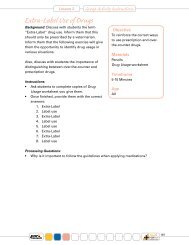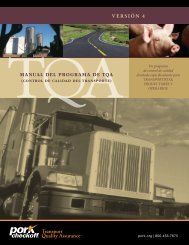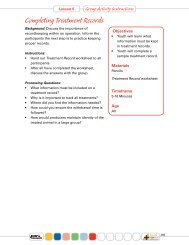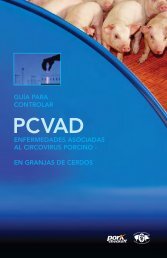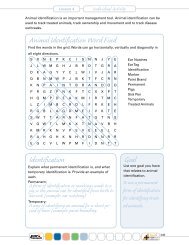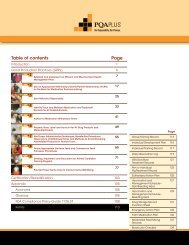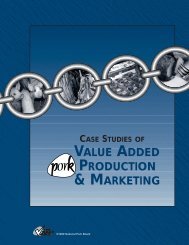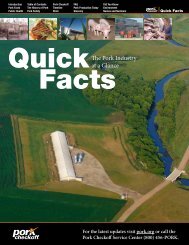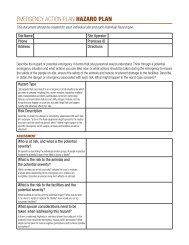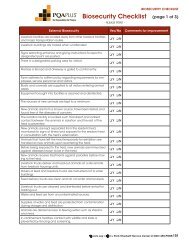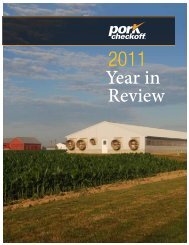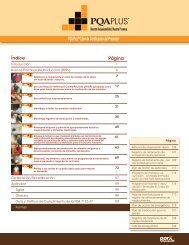PRRS Compendium Producer Edition - National Pork Board
PRRS Compendium Producer Edition - National Pork Board
PRRS Compendium Producer Edition - National Pork Board
You also want an ePaper? Increase the reach of your titles
YUMPU automatically turns print PDFs into web optimized ePapers that Google loves.
offset by any decrease in feed conversion). The<br />
net partial budget equation yields a value for net<br />
difference (ND). ND = [(AI + RE) – (RI + AE)]<br />
An example of the partial budget format is<br />
shown in Table 7.<br />
To use the partial budget assessment, estimate a<br />
value for each of the appropriate categories comparing<br />
the impact of the intervention strategy to<br />
your baseline (current performance with no intervention).<br />
Once all potential changes associated<br />
with the intervention are accounted for, a net<br />
difference to the operations can be calculated.<br />
The subtotal of (additional income + reduced expenses)<br />
minus the subtotal of (reduced income +<br />
additional expenses) is an estimate of the impact<br />
the intervention will have on the operation measured<br />
as a “net difference.”<br />
The net difference (or net return) for the interven- Additional facilities X<br />
tion can then be used to calculate the benefit: Table : Partial budget format with potential intervention<br />
cost ratio. The “net difference” from the partial<br />
budget includes the influence of the direct cost<br />
budget items<br />
of the intervention. In contrast, the “benefit:cost ratio” (BCR) is calculated by dividing the net return, excluding<br />
the direct cost of the intervention (DCI) (i.e., “benefit”), by the direct cost of the intervention (i.e.,<br />
“cost”), resulting in a “benefit:cost ratio.” That is, BCR = AI + RERI + AE - DCIDCI<br />
An example of the use of partial budgeting and the subsequent benefit:cost ratio is described in the literature<br />
as a case study in which the impact of vaccination with a modified-live <strong>PRRS</strong> vaccine at weaning in<br />
a system with a <strong>PRRS</strong> stabilized breeding herd and unstable growing pig herd was evaluated (Polson et<br />
al., 2000). Weighing the “benefit” (as measured by a reduction in mortality from 5 to 3% and an improvement<br />
in ADG from 0.59 to 0.79 pounds per head per day) against the “cost” (additional expense of vaccine<br />
and labor to administer) resulted in a benefit:cost ratio range of 2.4:1 to 22:1, depending upon the value of<br />
feeder pigs ($0.30 to 0.90 per pound).<br />
A BCR of 2.0 means that there is a $2.00 benefit for every $1.00 of direct intervention cost. In contrast, a<br />
BCR of 0.5 means that there is only a $0.50 benefit for every $1.00 of direct intervention cost. Where the<br />
BCR is 1.0, there would be a $1.00 benefit for every $1.00 of direct intervention cost.<br />
When doing partial budgets, it is also of value to do a “sensitivity analysis” (Boehlje and Eidman, 1984).<br />
As previously demonstrated in Table 3, a sensitivity analysis involves varying some of the input measures<br />
(impact on performance, feed cost, market price, intervention cost) to see how they change the output<br />
measure (net difference or benefit:cost ratio). In this way, you can assess the potential impact of an intervention<br />
if the effect was smaller and/or greater than what you expected.<br />
References<br />
Boehlje MD, Eidman VR. 1984. Farm Management, pp. 237-242.<br />
Potential intervention<br />
budget items<br />
Dee SA, Bierk MD, Deen J, Molitor TW. 2001. An evaluation of test and removal for the elimination of porcine reproductive and respiratory syndrome<br />
virus from five swine farms. Can J Vet Res 65:22-27.<br />
Dee SA, Joo HS, Park BK, et al. 1998. Attempted elimination of porcine reproductive and respiratory syndrome virus from a seedstock farm by<br />
vaccination of the breeding herd and nursery depopulation. Vet Rec 142:569-572.<br />
Dee SA, Joo HS, Polson DD, Marsh WE. 1997. Evaluation of the effects of nursery depopulation on the profitability of 34 pig farms. Vet Rec 140:498-500.<br />
Dee SA, Joo HS. 1993. <strong>PRRS</strong> clinical management and control: Eradication from herds. Proceedings of the Allen D. Leman Swine Conference, pp. 93-97<br />
Dee SA, Joo HS. 1994. Factors involved in successful eradication of <strong>PRRS</strong> virus using nursery depopulation. Proceedings of the American Association<br />
of Swine Practitioners, pp. 239-243<br />
Dee SA, Philips RC. 1998. Using vaccination and unidirectional pigflow to control <strong>PRRS</strong> virus transmission. Swine Health and Production 6(1):21-25.<br />
Additional<br />
income<br />
Potential outcomes<br />
Increased pigs weaned X<br />
Increased pounds sold X<br />
PAGE<br />
Reduced<br />
expenses<br />
Improved feed conversion X<br />
Reduced animal treatments X<br />
Potential intervention options<br />
Reduced<br />
income<br />
Additional<br />
expenses<br />
Diagnostic submissions X<br />
Vaccination X<br />
Labor X<br />
Closed herd/depopulation X<br />
PIG 04-01-09





